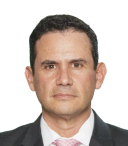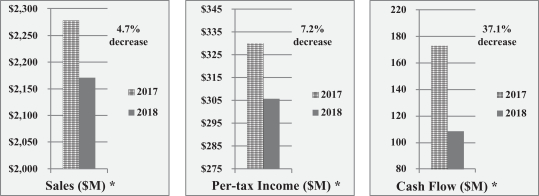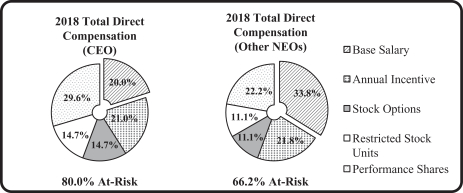COMPENSATION OF DIRECTORS AND EXECUTIVE OFFICERS
Compensation Discussion &and Analysis
This sectionCompensation Discussion and Analysis describes the programs and philosophy behind the Company’sour executive compensation practices for each individual who served asphilosophy and programs, the Company’s Chief Executive Officer during 2018, the Company’s Chief Financial Officer during 2018 and each of the three other most highly compensated executive officers in office at the end of 2018 (the “Named Executive Officers” or “NEOs”) and the process thatcompensation decisions the Compensation and Management DevelopmentHuman Capital Committee (the(for purposes of this Compensation Discussion and Analysis, the “Committee”) made under the program with respect to 2020, and the considerations in making those decisions with respect to 2020. Specifically, this Compensation Discussion and Analysis focuses on the compensation of the Board uses to determine executiveCompany’s Named Executive Officers (“NEOs”) listed below, whose compensation arrangements. In general,is set forth in the Company’s executive2020 Summary Compensation Table and other compensation program is designed to attract, retain and motivate executives while balancing both the short- and the long-term interests of the Company, its shareholders and its employees.tables contained in this proxy statement.
| | | | |
| | NamedExecutiveNamed Executive Officers (NEOs)
|
| | Miguel Fernandez | | |
• E.V. (Rick) Goings, Executive Chairman
| | |
• Patricia A. Stitzel, President and& Chief Executive Officer
|
| | Christopher D. O’Leary | | Former Interim Chief Executive Officer |
| | • Michael S. Poteshman, Cassandra (Sandra) E. Harris
| | Chief Financial Officer & Chief Operating Officer |
| | Richard (Rich) P. Goudis | | Executive Vice Chairman |
| | Karen M. Sheehan | | Executive Vice President and Chief FinancialLegal Officer & Secretary |
| | Patricio Cuesta | | President, Commercial |
| | • Simon C. Hemus, Vice ChairmanWilliam (Bill) J. Wright
| | |
• Asha Gupta, Executive Vice President, and Chief Strategy & Marketing OfficerProduct Innovation(1)
|
| | Justin Hewett | | |
• Luciano Garcia Rangel,Former Group President, Latin AmericaAsia Pacific(2)
| | |
| (1) | Mr. Wright ceased to be a Section 16 officer on October 12, 2020 upon his transition into the role of Executive Vice President, Product Innovation. |
| (2) | Mr. Hewett, the former Group President, Asia Pacific, left the Company on April 2, 2020. |
Summary
Management Succession and Transition
In May 2018,During 2020, as part of the Company’s Turnaround Plan, the Company appointed Patricia A. Stitzel toexperienced a number of senior leadership changes. On March 11, 2020, the position of President andBoard concluded its search for a new Chief Executive Officer following her electionand appointed Miguel Fernandez as President & Chief Executive Officer, effective April 6, 2020. Additionally, the Board appointed Richard Goudis as Executive Vice Chairman (“EVC”), effective March 12, 2020. Each of Messrs. Fernandez and Goudis also became a member of the Board member byon the Company’s shareholders at the 2018 annual meetingeffective date of shareholders. The direct compensation package for Ms. Stitzel,his appointment. Upon Mr. Fernandez commencing his service as described in the “Elements ofPresident & Chief Executive Officer, Direct Compensation” section below, increased her base salary from $550,000 to $850,000, her Annual Incentive Program (“AIP”) target bonus percentage from 80% to 105% (note that it was further increased to 115% in February 2019) and her 2018 stock grant fair value from $900,000 to $2,500,000. AsMr. O’Leary stepped down after serving as Interim Chief Executive Officer since November 12, 2019. In addition, as part of this CEO succession transition, E.V. (Rick) Goings retiredthe broad global leadership changes, on April 2, 2020, Mr. Hewett separated from the Company. Finally, as the Company’s CEO and was appointed its Executive Chairman. Mr. Goings’ direct compensation package decreased upon this transition, as his base salary went from $1,000,000 to $500,000, his AIP target bonus from 115% to 100% and his 2018 stock grant fair value from $5,000,000 to $2,000,000, in recognition of his reduced involvement in the day-to-day activitiespart of the business.
In addition, Simon C. Hemus retired fromongoing evolution of the Companysenior management team, on December 31, 2018, Luciano Garcia Rangel’s Group President, Latin America role was elevatedOctober 12, 2020, the Board appointed Ms. Harris to the executive officer level effective January 1, 2018, Asha Gupta was promotednew position of Chief Financial Officer & Chief Operating Officer and Mr. Wright to Executive Vice President, and Chief Strategy & Marketing Officer on August 1, 2018, Michael S. Poteshman retired fromProduct Innovation. Please see the Company on March 31, 2019, and Mr. Goings is retiring as Executive Chairman on May 22, 2019 (but is standingsection entitled “Management Transition Compensation Arrangements” forre-election as a director).discussion of the compensation arrangements entered into in connection with the 2020 management transitions.
Changes to 2019 Executive Compensation2020 Business Results
Based onThe Company is a review of trendsleading global consumer products company that designs innovative, functional, and environmentally responsible products. Founded in compensation program1946, the Company’s signature container created the modern food storage category that revolutionized the way the world stores, serves, and prepares food. Today, this iconic brand has more than 8,500 functional design and utility patents for solution-oriented kitchen and home products. With a purpose to nurture a better future, the desireCompany’s products are an alternative to best positionsingle-use items. The Company distributes its products into nearly 80 countries primarily through approximately 3.2 million independent sales force members around the world. Worldwide, the Company for growth and feedback from shareholders, the Committee has made changes to the 2019 executive compensation programs as described here andengages in the “Elementsmarketing, manufacture, and sale of Officer Direct Compensation” section below.
Beginning in 2019,design-centric preparation, storage, and serving solutions for the AIP design introducedkitchen and home through the Tupperware brand name and beauty products through the Fuller, NaturCare, Nutrimetics and Nuvobrands. Each brand manufactures and/or markets a local currency sales growth measurebroad line of achievement equalhigh-quality products. The Company primarily uses a direct selling business model to 25% of the potential award along with incomedistribute and cash flow measures accounting for 50% and 25%, respectively. The sales measure includes a tripwire, whereby no award will be paid based on sales performance unless at least threshold performance is met under the program’s income measure. The Committee believes that this choice of metrics and weightings mix best positions the Company for long-term success.
Following the Committee’s review, and in consultation with its executive compensation consultant, the November 2018 stock-based incentive program grants changed from a previously weighted mix of 45% stock options and 55%market products,












































 Please fold here – Do not separate
Please fold here – Do not separate 



